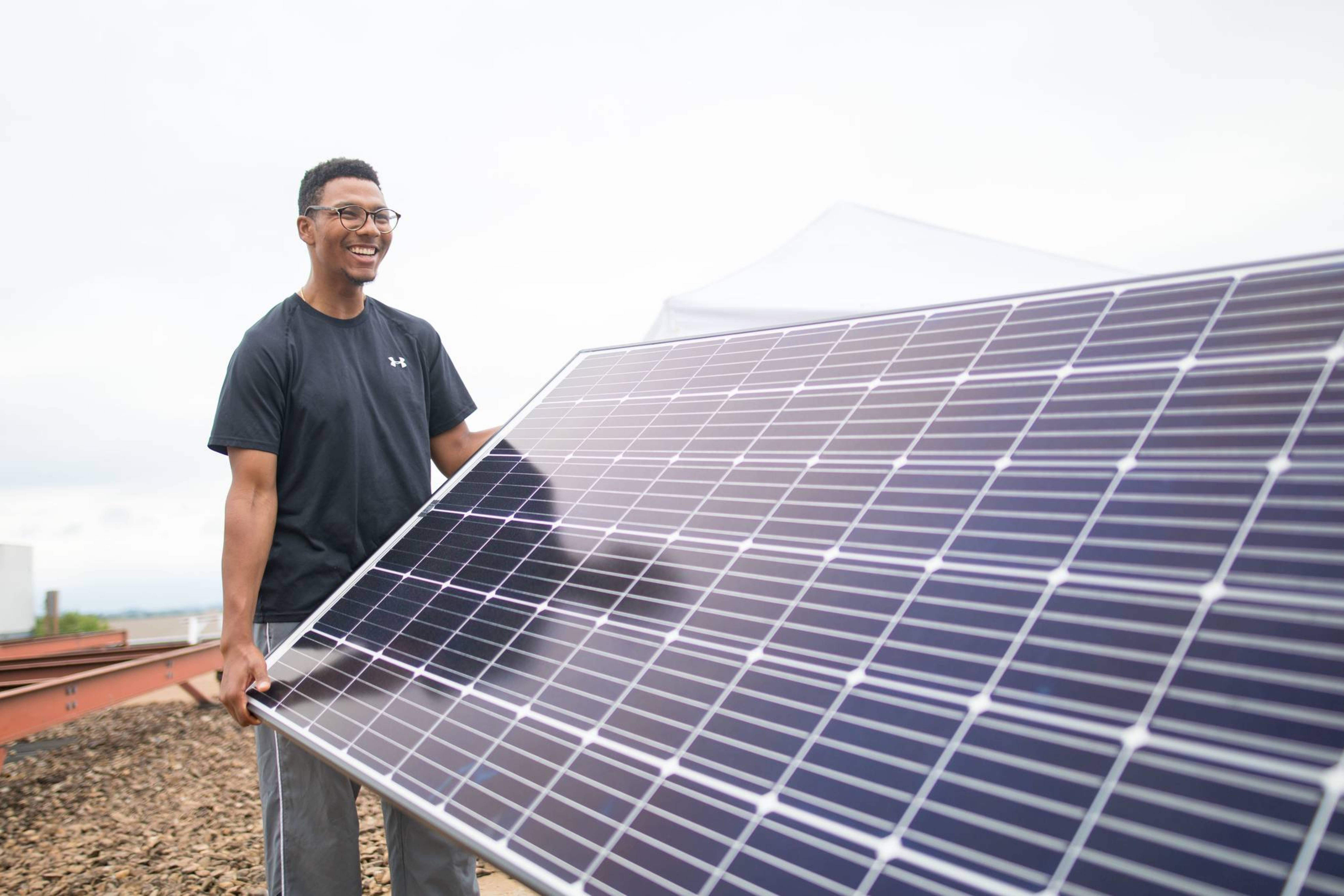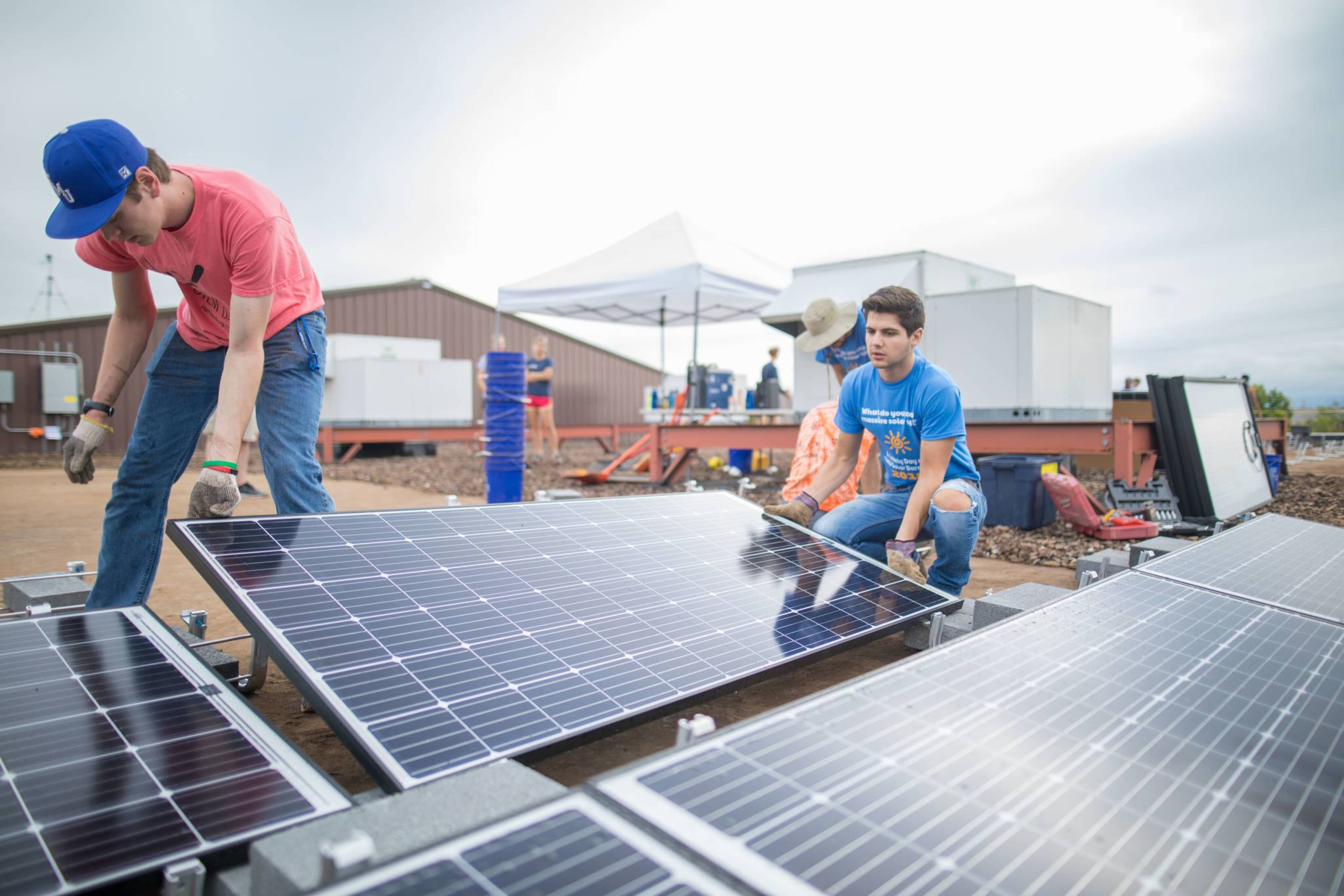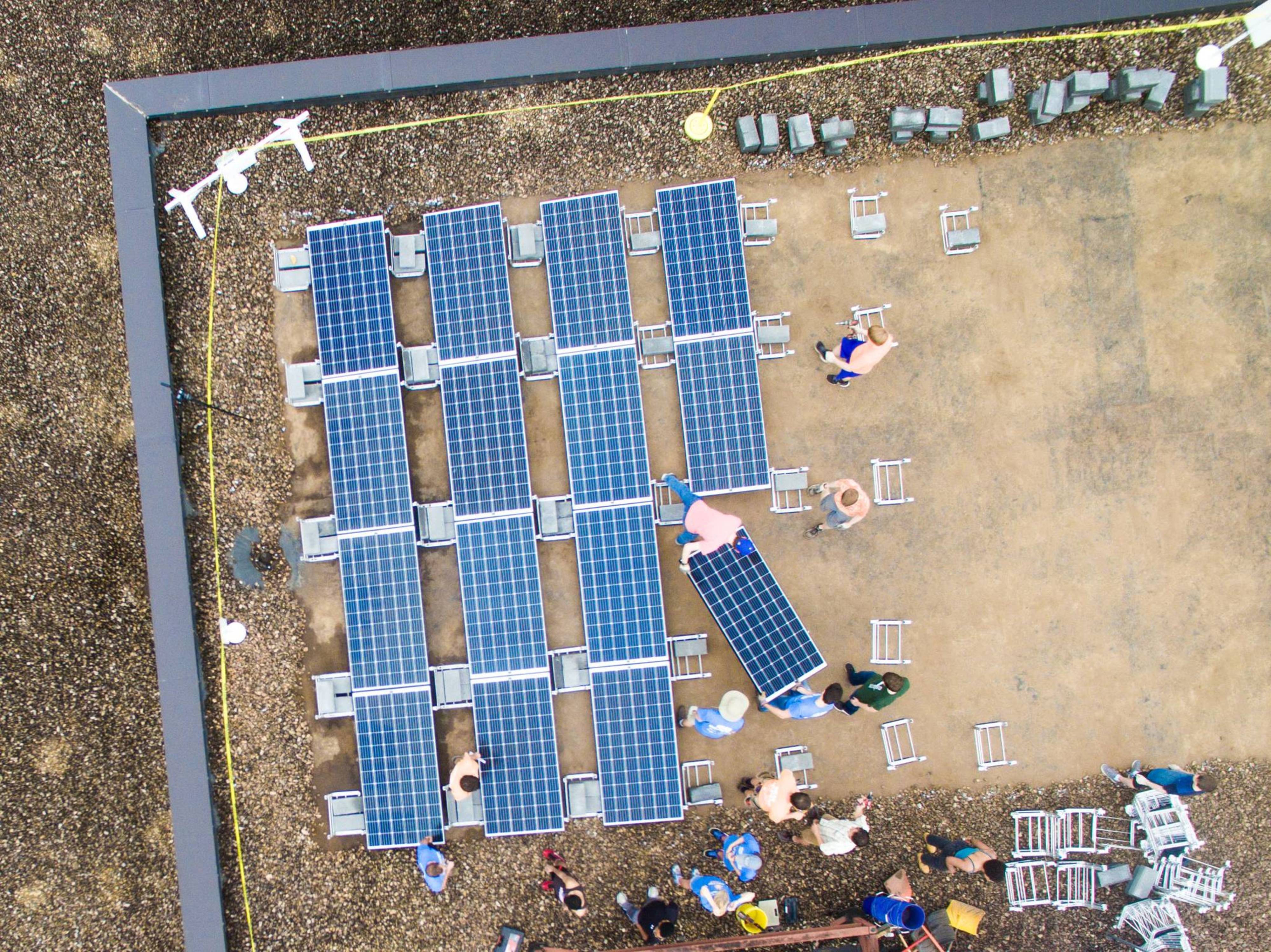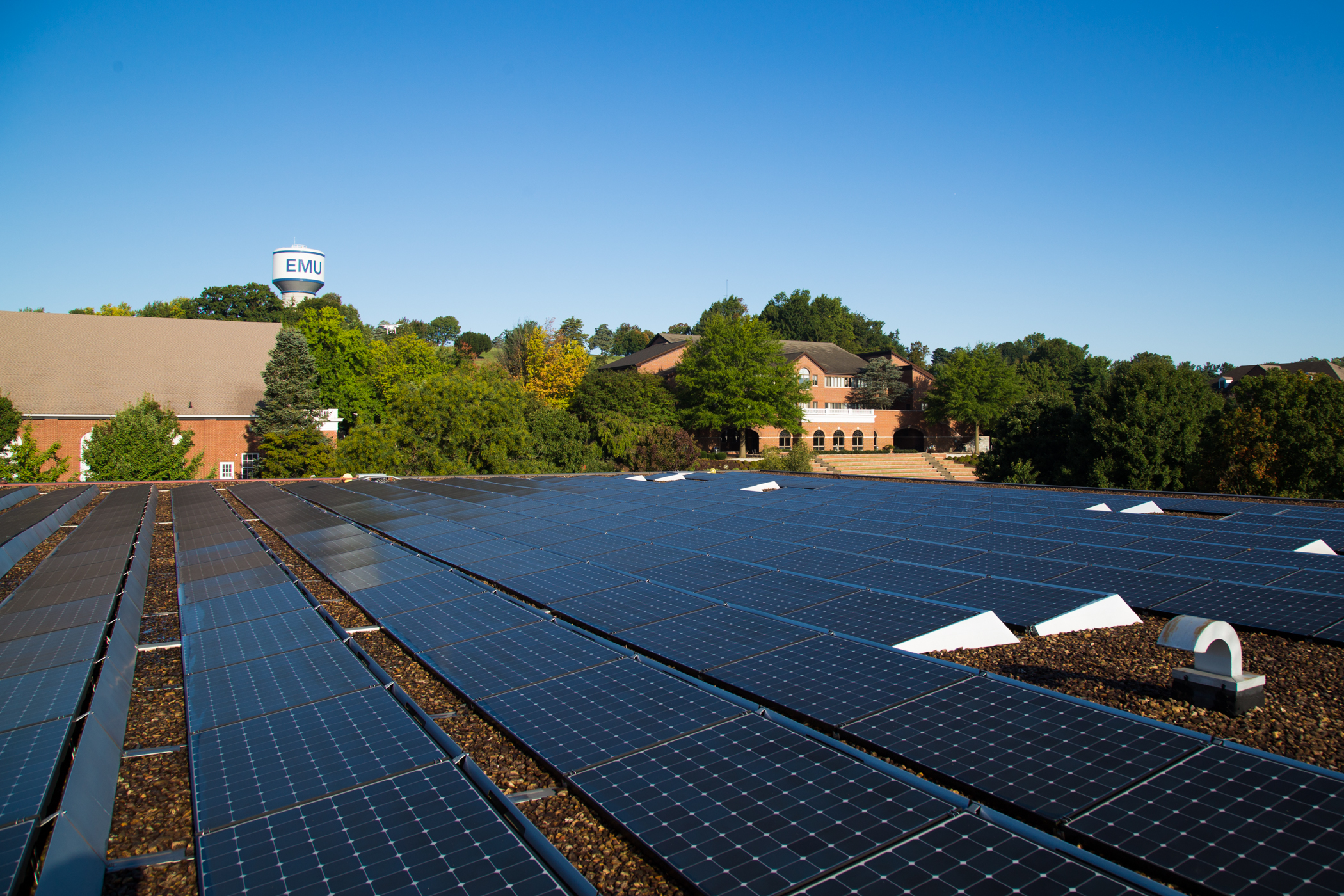Solar Project
When EMU launched a solar array on the roof of Hartzler library in 2010, it was:
- the largest commercial scale (first over 100 kW) solar project in the state;
- the first privately financed, commercial scale solar array in Virgina;
- a catalyst for a new municipal solar “net metering policy” to benefit all Harrisonburg City electric customers.
Within 15 days, the array had already offset several barrels of oil, more than three trees, and over 4,000 pounds of carbon. Over the next 10 months, the array exceeded its anticipated output by 12 percent.
Secure Futures, a solar development company based in Staunton, Virginia, owns and operates the EMU solar installation through its subsidiary, Community Solar. View a video by Secure Futures about our solar array.
Learn more about the Hartzler Library Solar Array on this dashboard.
Roselawn and University Commons (Student Solar Project)
The 66 solar panels on top of Roselawn and the 120 panels on top of University Commons combine for a total of 65.2 kilowatts. These arrays were installed as a part of the Student Solar Project during the 2017-2018 school year - a project that was led by a variety of groups on campus with contributions from multiple disciplines including Engineering, Business and Economics, and Computer Science. To read more information click here.
Key Points to Remember
The solar project is complex. Here are some key points to remember.
- Savings are likely over the long run. Based on the history of annual increases in electricity prices in the United States, EMU has projected that it is highly likely that it will save money over the next 20 years and beyond with these solar panels.
- Solar is less of a burden on taxpayers when all factors are considered. Taxpayers, through our government entities, provide subsidies for oil and gas exploration, transportation, and refining. In addition, large sums of tax dollars go toward defense efforts to protect oil and gas resources, as well as toward cleaning up the environmental damage caused by spills and extraction processes, and toward addressing air pollution caused by the burning of fossil fuels.
- The project results in reasonable payments for our solar power. Under our arrangement with Secure Futures, Inc., we are paying rates that are contractually set for 20 years, allowing us to predict how much we will pay for the energy generated by the solar panel array 10, 15 and 20 years from now.
- The project is a step in the right direction. Our solar panels provide only a small portion of the power that we use, but we must start somewhere. They are a step in the right direction, toward relying on renewable, non-polluting energy sources.
About EMU’s Solar Project
In 2010, EMU entered into a 20-year power purchase agreement with Community Solar to buy the solar-generated electricity at a “grid-parity” price equivalent to the rate that EMU pays for power from its current provider. EMU agreed to pay in advance for 10 years of the guaranteed solar electricity output at the outset of the project, which reduces project financing costs. In return, Community Solar will pass savings back to EMU as an annual credit.
Southern Energy Management, a North Carolina-based energy efficiency and solar power company, installed and maintains the solar panels for Community Solar.
Using economic stimulus funds provided by the American Recovery and Reinvestment Act (ARRA) of 2009, the Virginia Department of Mines, Minerals and Energy (DMME) awarded an incentive grant for the project. ARRA funds through the US Treasury 1603 Investment Tax Credit grant will also help finance this project. Community Bank in Staunton, VA, provided construction financing for this project.
Campus Effects
Stewardship of God’s creation is a core value of EMU. The solar project will cut EMU’s usage and peak demand energy costs and thus reduce reliance on power generated by coal and other fossil fuels. It will also eliminate more than 6,000 tons of greenhouse gas emissions over the projected 35-year life of the solar panels. The array performance was exceeding output expectations 10 months into operation.
Power generated by the panels goes first to the library distribution system. On most days when the library is in operation all power generated is used for lighting, climate control and information technology. If the library is closed – on a sunny day – excess power flows into the campus grid. If more solar power collectors are added on campus, there will be occasions – spring break and summer – when the campus grid has excess power. Excess capacity will flow to the Harrisonburg Electric Commission (HEC) utility grid for a set price.
EMU has a 20-year power purchase agreement to buy the solar-generated electricity at a “grid-parity” price equivalent to the rate that EMU pays for power from HEC.
Financial Supporters
As part of the innovative business model, EMU has agreed to pay in advance for 10 years of the guaranteed solar electricity output at the outset of the project, which reduces project financing costs. In return, Secure Futures will pass savings back to EMU as an annual credit.
Using economic stimulus funds provided by the American Recovery and Reinvestment Act (ARRA) of 2009, Department of Mines, Minerals and Energy (DMME) awarded an incentive grant for the project. ARRA funds through the US Treasury 1603 Investment Tax Credit grant will also help finance the project. Community Bank in Staunton, Virginia, provided construction financing.
An FAQ for the project and projected annual pollution savings for EMU are on the Secure Futures website.
About Secure Futures
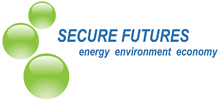 Secure Futures designs, develops and finances distributed solar solutions with and for tax-exempt
entities to reduce their electricity costs and to protect against future grid price
increases through 20 to 25 year Solar Power Purchase Agreements (SPPAs).
Secure Futures designs, develops and finances distributed solar solutions with and for tax-exempt
entities to reduce their electricity costs and to protect against future grid price
increases through 20 to 25 year Solar Power Purchase Agreements (SPPAs).
About Southern Energy Management
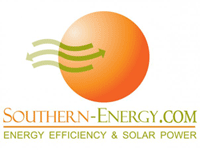 Southern Energy Management is a North Carolina-based sustainable energy company offering energy efficiency, green
building and turn-key solar services for homeowners, builders, companies, government
and military clients across the Southeast.
Southern Energy Management is a North Carolina-based sustainable energy company offering energy efficiency, green
building and turn-key solar services for homeowners, builders, companies, government
and military clients across the Southeast.
A certified B Corp, SEM’s mission is to have a measurable impact on reducing greenhouse gas emissions that contribute to climate change, and to build a sustainable triple-bottom-line company.



